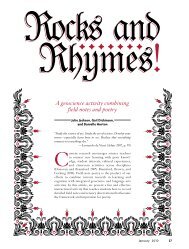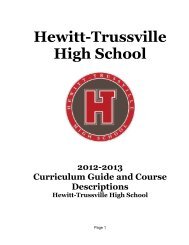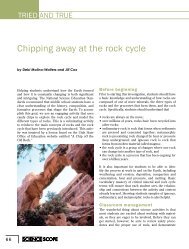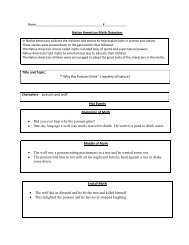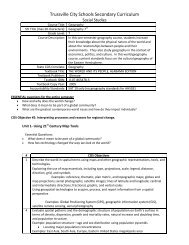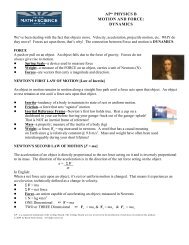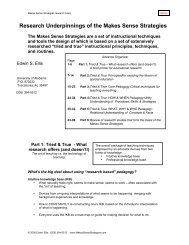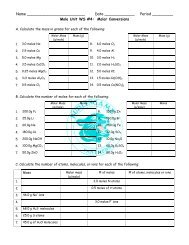The Pet Rock Project - NSTA Learning Center
The Pet Rock Project - NSTA Learning Center
The Pet Rock Project - NSTA Learning Center
You also want an ePaper? Increase the reach of your titles
YUMPU automatically turns print PDFs into web optimized ePapers that Google loves.
SCIENCE SAMPLER<br />
FIGURE 5<br />
“Dat,” a piece of scoria, was<br />
altered only by the addition of<br />
his “team symbol.” <strong>The</strong> rock’s<br />
story and relationship within<br />
the rock cycle are presented in<br />
Figure 6.<br />
FIGURE 6<br />
Student submission of pet rock<br />
relationships. This story exhibits<br />
a higher level of creativity than<br />
typical student submissions.<br />
Conclusion<br />
Students may often encounter so many facts, concepts,<br />
and theories in a science class that they exit the class at<br />
the end of the year with only a skeletal understanding of<br />
isolated scientific principles. Some constructs in Earth<br />
science, such as plate tectonics and the rock cycle,<br />
are unifying themes in the geosciences and deserve<br />
more than a cursory glance by students. Thorough<br />
understanding of these important constructs provides<br />
a knowledge base within Earth science on which<br />
further topics can be linked and scaffolded. We think,<br />
based on students’ submitted projects and anonymous<br />
student survey data, that the <strong>Pet</strong> <strong>Rock</strong> <strong>Project</strong> was<br />
successful in promoting a more in-depth understanding<br />
of the rock cycle. Because the project involves the<br />
“adoption” of a rock, we think that the <strong>Pet</strong> <strong>Rock</strong> <strong>Project</strong><br />
may possibly promote personal meaning-making in the<br />
classroom by targeting students’ affective as well as<br />
their intellectual domains, and giving students multiple<br />
relevant opportunities to retrace and internalize rock<br />
cycles’ subpathways. Furthermore, varying degrees of<br />
content knowledge may be easily incorporated within<br />
the assignment so that it can be implemented at various<br />
grade levels. We encourage other science teachers to<br />
creatively explore the investigation of rock properties<br />
and the rock cycle through the <strong>Pet</strong> <strong>Rock</strong> <strong>Project</strong>.<br />
References<br />
Bybee, R.W., and A.H. Pratt. 1996. National standards: Challenges<br />
for Earth science education. Geotimes 41: 16–19.<br />
Clary, R.M., and J.H. Wandersee. 2006. A writing template<br />
for probing students’ geological sense of place. Science<br />
Education Review 5 (2): 51–59.<br />
Frack, S., and S.A. Blanchard. 2005. <strong>Rock</strong>in’ around the<br />
rock cycle. Science Scope 29 (2): 62.<br />
Lyell, C. 1838. Elements of geology. London: John Murray.<br />
Mantell, G. 1836. Thoughts on a pebble, or a first lesson<br />
in geology. London: Relfe and Fletcher.<br />
Mintzes, J.J., J.H. Wandersee, and J.D. Novak, eds. 1998.<br />
Teaching science for understanding: A human constructivist<br />
view. San Diego, CA: Academic Press.<br />
O c t o b e r 2007 6 3



